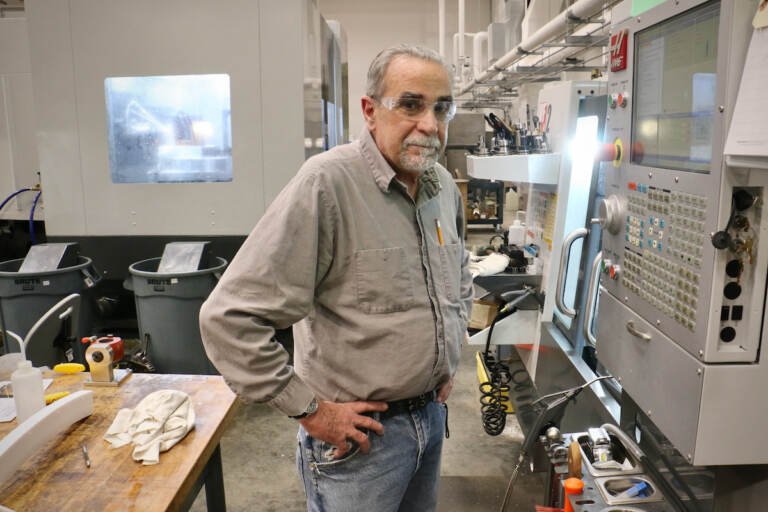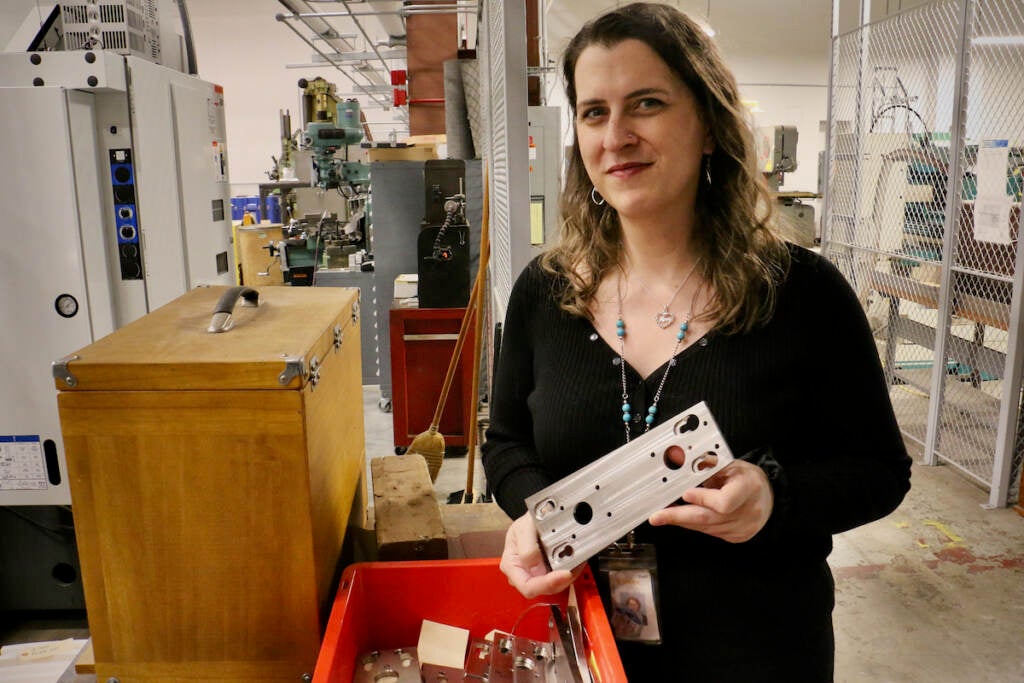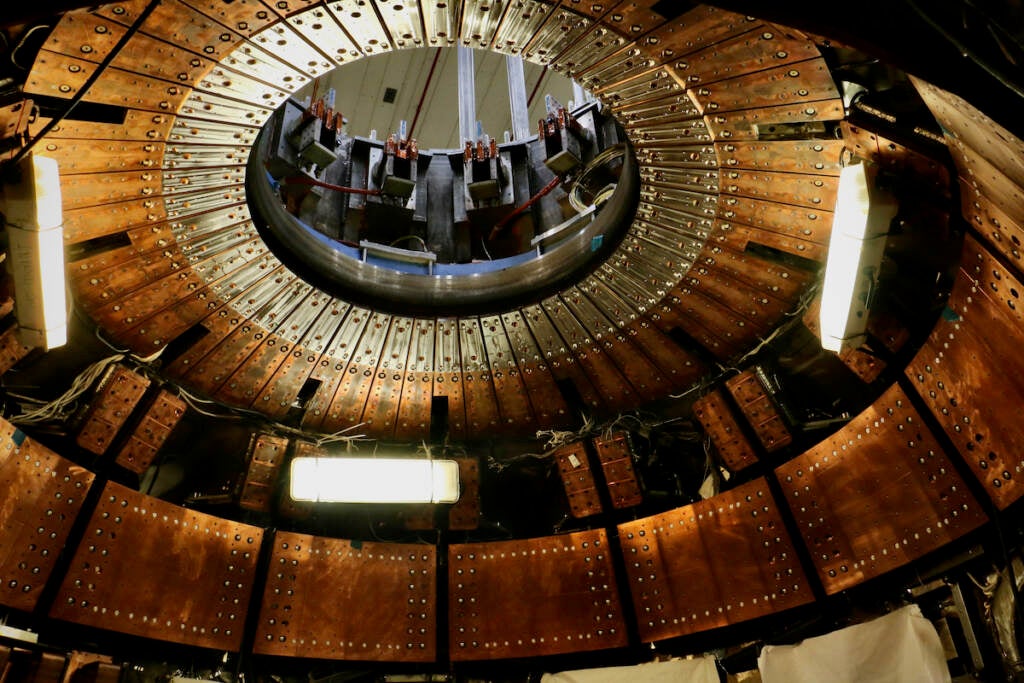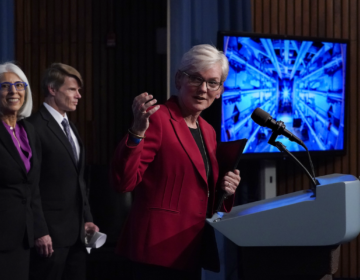Behind the scenes of a $200 million nuclear fusion experiment
How scientists and engineers make parts for a nuclear fusion experiment at the Princeton Plasma Physics Laboratory in New Jersey.
Listen 8:58
Senior machinist Joe Diamond is working on the stainless steel transition plates that will be installed inside the vacuum vessel and on the center stack. (Emma Lee/WHYY)
This story is from The Pulse, a weekly health and science podcast.
Find it on Apple Podcasts, Spotify, or wherever you get your podcasts.
Machinist Joe Diamond has made parts for cars, trains, and nuclear submarines, but he said a stainless steel plate is among the hardest things he’s had to make.
He’s been making machine parts for more than 50 years, and now he works at the Princeton Plasma Physics Laboratory. The lab does experiments on nuclear fusion, which scientists have dreamed of using as a source of energy on earth for more than half a century. It’s what happens at the center of the sun.
Part of the difficulty is designing and building the equipment to test this on Earth, said Stefan Gerhardt, one of the physicists directing the project.
“It’s very easy to design something that nobody on earth can build,” he said. “And so, all of these fancy ideas about physics and design engineering have to be constrained by what can be done with finite money and time, by real people, with real machine tools. There is constant tension in my business in evaluating … that interplay. That’s both what makes it interesting and what makes it hard.”
The stainless steel plate Joe Diamond needs to make is about 10 inches long, half an inch thick, and in the shape of a trapezoid. The tricky part is that the plates are tapered, and not the same thickness the whole way through. Diamond has to cut out a piece of stainless steel and carefully shave off metal from one end, so it ends up angled in just the right way.
Why is this angle so important?
To picture this $200 million fusion experiment, think of a 15-foot-tall apple, made of metal. When the machine is turned on, the core of the apple holds a gas that is so hot, it matches the temperature at the center of the sun, over 10 million degrees Celsius. That turns the gas into a different state of matter altogether, called plasma. The sun uses gravity to hold the ultra-hot plasma.
Subscribe to The Pulse
In the experiment, the core of the apple faces the plasma, and is lined with flat carbon tiles. Those tiles can take the heat and carry it safely outside.
But the problem is the lab cannot make a metal apple such that those flat tiles perfectly cover the surface of the apple core. To fix this problem, scientists designed the stainless-steel plates to go somewhere between the core of the apple and the outer shell and help align the carbon tiles, which cannot be off by more than 0.01 inches.
Because if the carbon tiles aren’t lined up correctly, they could get too hot, parts of it could fall into the plasma, and the experiment won’t get as hot as the scientists need it to be.
A pile of maybe 10 of these stainless-steel plates took almost a year to make, and the scientists made some changes, so it will take more time.

The potential consequences for getting something wrong can be serious. Back in 2016, the lab had just finished a four-year-upgrade program, but then one of the magnets used to help hold the ultra-hot plasma failed. The device was shut down for months. The lab director at the time resigned after an eight-year-long career. One Science article called it a body blow to the lab.
Physicist Stefan Gerhardt said they worked to make sure a mistake like that does not happen again, and they increased their already high standards for parts.
For instance, he said that when the lab asked companies to make more of these magnets, the lab tested the magnets by cutting them up to check for hidden flaws, which they had never done to prototype magnets before. The lab also asked the companies making the magnets to make sure that they had a clean room, free of dust, or other metal work going on that could contaminate the magnets being made.
“You want to make sure that all the workers, if they’re touching this, have gloves on so the oils of their hands don’t get in. You want to make sure that nobody comes in here and marks with a pencil or a Sharpie.”
A company in France made some of the magnets. To make sure the company followed the lab’s specifications, the Princeton lab sent people to France in 2020 to watch the magnets being made. When the COVID-19 pandemic began, the lab scrambled to get those people back to the U.S.
The lab is still getting new parts and putting them into the machine to make sure everything fits.
“These are … complex assemblies. It’s a very large Swiss watch we sometimes like to tell each other,” Gerhardt said.
And it does require people who know how to coordinate this finely tuned Swiss watch with hundreds of machinists, engineers, and scientists all working on this one experiment, which has potential hazards around radiation, electricity, as well as mechanical problems. For instance, Gerhardt said one of the project managers on the team used to run a nuclear power plant.
“There’s many systems that have to work simultaneously,” Gerhardt said. “And so … once it’s built, a lot of focus goes into … carrying quality and safety into operations and making sure these complex systems work together every day when the science users are present and wanting to get some science done.”

Right now, the goal is to have the machine ready to be turned on in a few years. Scientists can then use it to do experiments and figure out how to control and work with the ultra hot plasma to someday, maybe, use it to generate huge amounts of power. In the meantime they are designing, assembling, and fine tuning all the components, one plate at a time.
WHYY is your source for fact-based, in-depth journalism and information. As a nonprofit organization, we rely on financial support from readers like you. Please give today.







